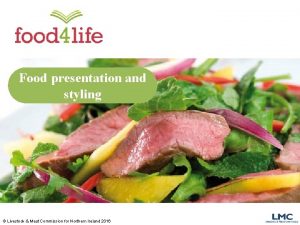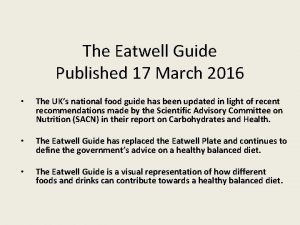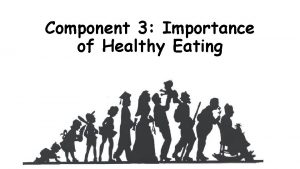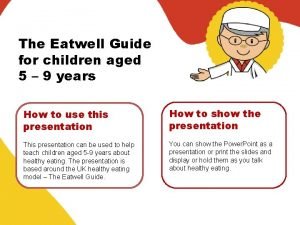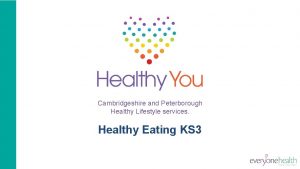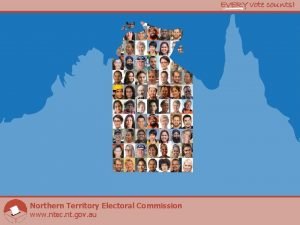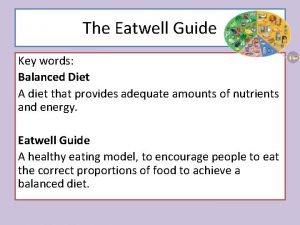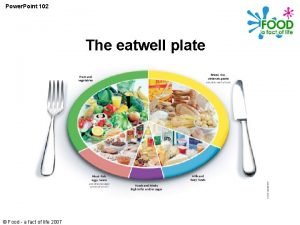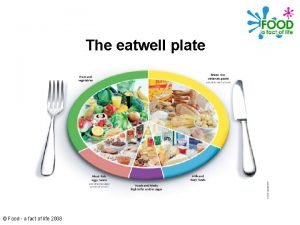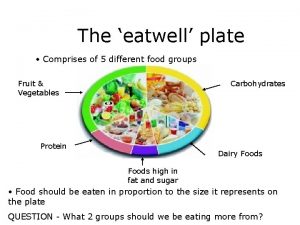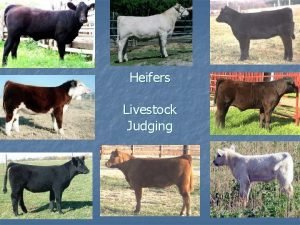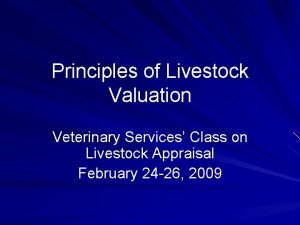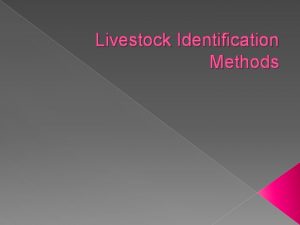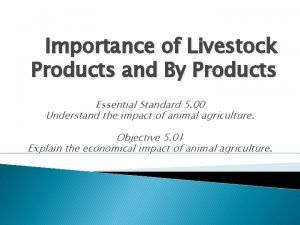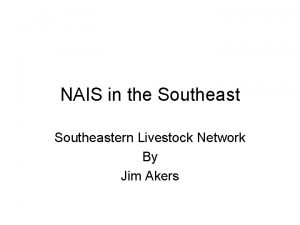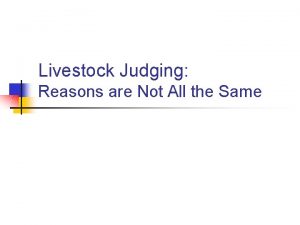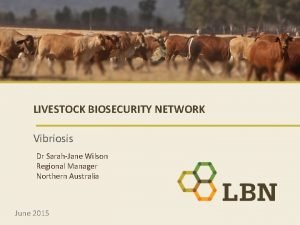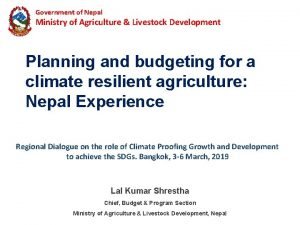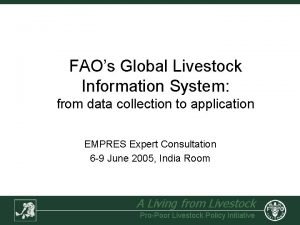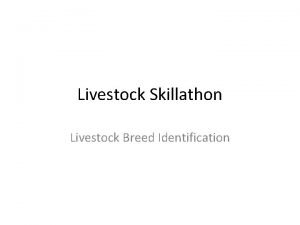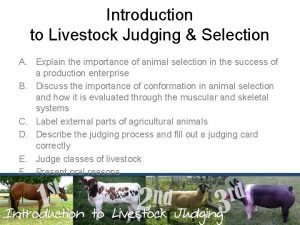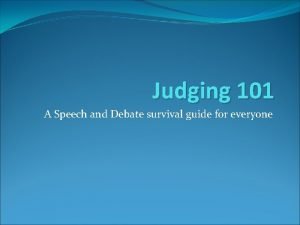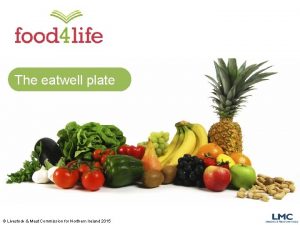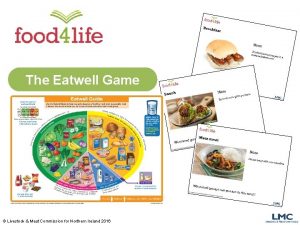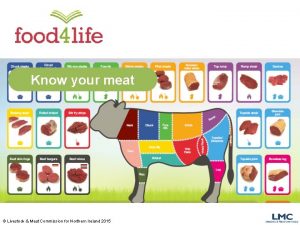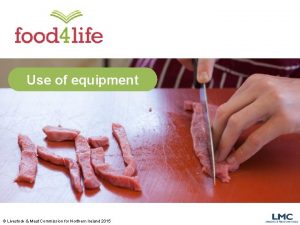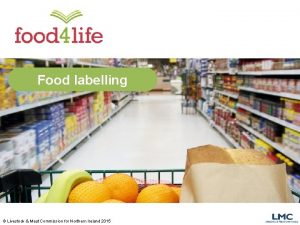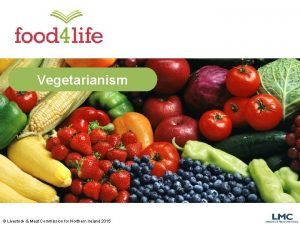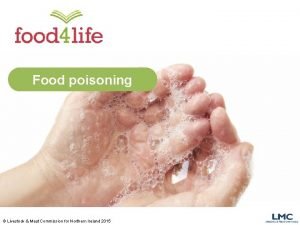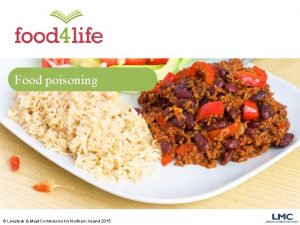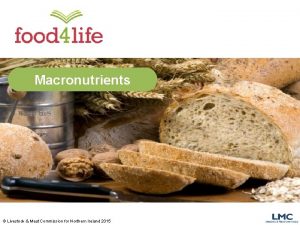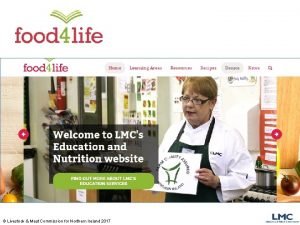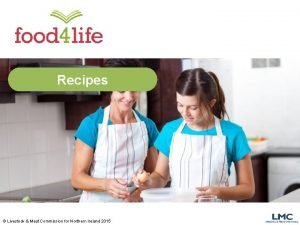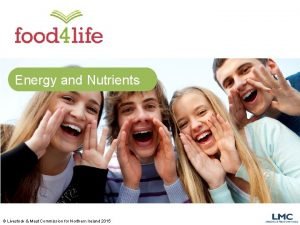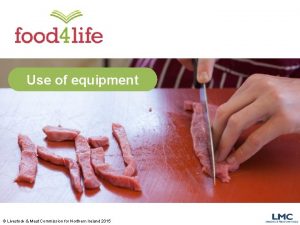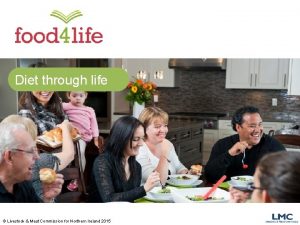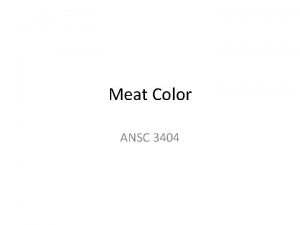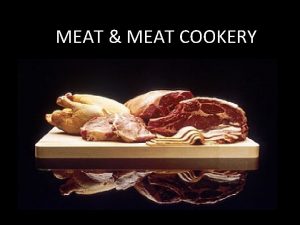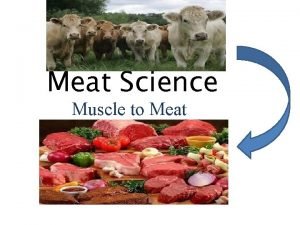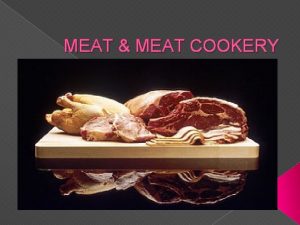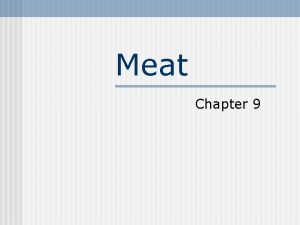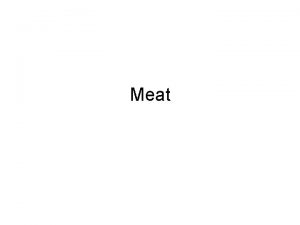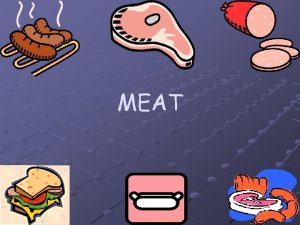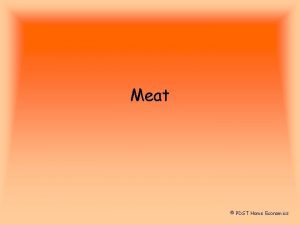The Eatwell Guide Livestock Meat Commission for Northern



























- Slides: 27

The Eatwell Guide © Livestock & Meat Commission for Northern Ireland 2016

Learning Objectives The key learning objectives for this section are that you will: • Recognise and describe the Eatwell Guide; • Identify each of the five groups of the Eatwell Guide and provide examples of food and/or drink in each group. © Livestock & Meat Commission for Northern Ireland 2016

A healthy varied diet Apart from breastmilk as a food for babies, no single food contains all the essential nutrients the body needs to be healthy and function efficiently. The nutritional value of a person's diet depends on the overall balance of foods that is eaten over a period of time, as well as on the needs of the individual. A healthy diet is likely to include a variety of foods, from each of the main food groups, as this allows us to get all the nutrients that we need. All food and drinks can be part of a healthy diet but it is important to get the balance right! © Livestock & Meat Commission for Northern Ireland 2015 2016

The Eatwell Guide Public Health England (PHE) regularly reviews dietary recommendations as part of its role in promoting public health. In light of new evidence about our diet and health, particularly revised recommendations on sugars and fibre, a review of The eatwell plate was undertaken. As a result of the review, a new healthy eating guide for the UK has been developed. The Eatwell Guide. © Livestock & Meat Commission for Northern Ireland 2016

What changes can you see? © Livestock & Meat Commission for Northern Ireland 2015 2016

What has changed? The name has changed. Illustrations of foods and drinks are used. Guidance on healthy hydration has been added. A front-of-pack nutrition label has been added. The knife and fork have been removed. Foods high in fat and/or sugars have been removed from the purple segment. © Livestock & Meat Commission for Northern Ireland 2016 Additional messaging is provided for each food group.

What has changed? Fruit juice is now included in the hydration message (not illustrated pictorially in this group) but a maximum of 150 ml still counts as one portion of 5 A DAY. The purple segment now only contains unsaturated oils and fat spreads, which eaten in small amounts, provide the types of fat that are essential. © Livestock & Meat Commission for Northern Ireland 2016

The Eatwell Guide – key messages The Eatwell Guide shows the proportions in which different groups of foods are needed in order to have a well-balanced and healthy diet. The proportions shown are representative of food eaten over a day or more, not necessarily at each meal time. Choose a variety of different foods from each food group to help get the wide range of nutrients the body needs to stay healthy. © Livestock & Meat Commission for Northern Ireland 2015 2016

The Eatwell Guide – key messages The Eatwell Guide applies to most people regardless of weight, dietary restrictions/preferences or ethnic origin. It does not apply to children under two years because they have different nutritional needs. Children aged two to five years should gradually move to eating the same foods as the rest of their family, in the proportions shown on the Eatwell Guide. © Livestock & Meat Commission for Northern Ireland 2016

The Eatwell Guide – key messages Anyone with special dietary requirements or medical needs might want to check with a registered dietitian on how to adapt the Eatwell Guide to meet their individual needs. The Eatwell Guide divides foods into groups, depending on their nutritional role and shows the proportions of each of the groups needed for a healthy, varied diet. © Livestock & Meat Commission for Northern Ireland 2016

The Eatwell Guide is made up of five food groups: • Fruit and vegetables; • Potatoes, bread, rice, pasta and other starchy carbohydrates; • Beans, pulses, fish, eggs, meat and other proteins; • Dairy and alternatives; • Oils and spreads. © Livestock & Meat Commission for Northern Ireland 2015 2016

Fruit and vegetables should make up just over one third of our daily food intake. Try to include some at every meal and for snacks. Aim to eat at least five portions of fruit and vegetables each day. Choose a wide variety of fruits and vegetables as they all have different proportions of vitamins and minerals that help to keep us healthy. They also contribute to the recommended daily intake of 30 g fibre. © Livestock & Meat Commission for Northern Ireland 2015 2016

What is a portion? One adult portion of fruit or vegetables is 80 g or any of these: • 1 apple, banana, pear, orange or other similarsize fruit; • 3 heaped tablespoons of vegetables; • a dessert bowl of salad; • 30 g of dried fruit (counts as a maximum of one portion a day); • 150 ml glass of fruit juice or smoothie (counts as a maximum of one portion a day). Chose from fresh, frozen, dried, canned and juiced types. © Livestock & Meat Commission for Northern Ireland 2015 2016

Do you eat 5 a day? With just a little planning, we can make sure we get our 5 A DAY. Think about the following meal occasions, how could you include a portion of fruit or vegetables? Breakfast Dried or fresh fruit with cereal, glass of juice Mid morning snack Piece of fruit Lunch Beans on toast or a bowl of salad Mid afternoon snack Vegetable sticks with hummus Dinner Mixed vegetables and canned fruit in juice © Livestock & Meat Commission for Northern Ireland 2015 2016

Potatoes, bread, rice, pasta and other starchy carbohydrates Just over one third of our total daily food intake should be from this group. Choose higher-fibre, wholegrain varieties such as wholewheat pasta, brown rice, or simply leaving the skins on potatoes. Base your meals around starchy carbohydrate foods: • start the day with a wholegrain breakfast cereal; choose one lower in salt and sugars; • have a sandwich for lunch; • choose potatoes, pasta or rice as a base for your evening meal. © Livestock & Meat Commission for Northern Ireland 2015 2016

Potatoes, bread, rice, pasta and other starchy carbohydrates Choose high fibre or wholegrain varieties as much as possible as these usually contain more fibre, vitamins and minerals than refined versions. This group can provide carbohydrate, fibre, B vitamins, iron, calcium and folate. Wholegrain food includes: • wholemeal and wholegrain bread, pitta and chapatti; • wholewheat pasta; • brown rice; • wholegrain breakfast cereals and whole oats. © Livestock & Meat Commission for Northern Ireland 2015 2016

Potatoes, bread, rice, pasta and other starchy carbohydrates What examples can you think of? Breakfast © Livestock & Meat Commission for Northern Ireland 2015 2016 Lunch Dinner

Beans, pulses, fish, eggs, meat and other proteins A moderate amount of these foods is needed in the diet. These foods are sources of protein, vitamins and minerals, so it is important to eat some foods from this group. This group includes beef, lamb, eggs, fish, pulses and beans. © Livestock & Meat Commission for Northern Ireland 2015 2016

Beans, pulses, fish, eggs, meat and other proteins Some types of meat are high in fat, particularly saturated fat. To cut down on fat: • choose lean cuts of meat and go for leaner mince; • cut the fat off of meat and the skin off of chicken; • grill meat and fish instead of frying. If you eat more than 90 g of red or processed meat per day, try to cut down to no more than 70 g per day. Most people eat around 70 g a day. © Livestock & Meat Commission for Northern Ireland 2016

Dairy and alternatives A moderate amount of these foods is needed in the diet. Try to have some milk and dairy food (or dairy alternatives) such as cheese, yoghurt and fromage frais. These are good sources of protein and vitamins, and an important source of calcium. Some dairy food can be high in fat and saturated fat, choose lower fat and lower sugar products where possible. Try: • 1% fat milk; • reduced fat cheese; • have a smaller amount of the full-fat varieties less often; • choose unsweetened, calcium-fortified versions when buying dairy alternatives. © Livestock & Meat Commission for Northern Ireland 2015 2016

Oils and spreads It is important to have some fat in your diet, but generally we are eating too much saturated fat and need to reduce the amount we consume. Unsaturated fats are healthier fats that are usually from plant sources and in liquid form as oil. Swapping to unsaturated fats helps to reduce cholesterol in the blood, therefore it is important to get most of our fat from unsaturated oils. All types of fat are high in energy and should be in the diet. © Livestock & Meat Commission for Northern Ireland 2015 2016 limited

Hydration Aim to drink 6 -8 glasses of fluid every day. Water, lower fat milk and sugar-free drinks, including tea and coffee all count. Fruit juice and smoothies count towards your fluid consumption. They are a source of free sugars so should be limited to no more than a combined total of 150 ml per day. Sugary drinks are one of the main contributors to excess sugar consumption amongst children and adults in the UK. Swap sugary soft drinks for diet, sugar-free or no added sugar varieties to reduce your sugar intake. © Livestock & Meat Commission for Northern Ireland 2016

Foods high in fat, salt and sugars This includes products such as chocolate, cakes, biscuits, full-sugar soft drinks, butter and ice cream. These foods are not needed in the diet. If they are included, have infrequently and in small amounts. If you consume these foods and drinks often, try to limit your intake so you have them less often and in smaller amounts. Food and drinks high in fat and sugar contain lots of energy, particularly when you have large servings. Check the label and avoid foods which are high in fat, salt and sugar! © Livestock & Meat Commission for Northern Ireland 2015 2016

The Eatwell Guide – key message summary Eat at least 5 portions of a variety of fruit and vegetables every day. Base meals on potatoes, bread, rice, pasta or other starchy carbohydrates; choosing wholegrain versions where possible. Have some dairy or dairy alternatives (such as soya drinks); choosing lower fat and lower sugar options. Eat some beans, pulses, fish, eggs, meat and other proteins. Choose unsaturated oils and spreads and eat in small amounts. Drink 6 -8 cups/glasses of fluid a day. © Livestock & Meat Commission for Northern Ireland 2016

Composite dishes A lot of the dishes and meals we eat are made up of foods from more than one group of the Eatwell Guide. These are called composite dishes. What examples can you name? © Livestock & Meat Commission for Northern Ireland 2015 2016

Composite foods Suggest which food groups should be added to each recipe to make a balanced meal. Creamy peppered beef Beef, Stout and Mushroom pie www. food 4 life. org. uk - recipes © Livestock & Meat Commission for Northern Ireland 2015 2016 Thai red beef curry

For further information, go to: www. food 4 life. org. uk © LMC 2016 © Livestock & Meat Commission for Northern Ireland 2015 2016
 Livestock meat commission
Livestock meat commission Eatwell guide
Eatwell guide British nutrition foundation eatwell guide
British nutrition foundation eatwell guide Eatwell guide 2016
Eatwell guide 2016 Eatwell guide
Eatwell guide Eatwell guide for kids
Eatwell guide for kids Eatwell guide quiz
Eatwell guide quiz Territory
Territory Make a research about market forms of poultry
Make a research about market forms of poultry Mudaliar commission objectives
Mudaliar commission objectives Marie earns an 8 commission
Marie earns an 8 commission The eatwell challenge
The eatwell challenge Eatwell plat
Eatwell plat Eatwell plate definition
Eatwell plate definition Eatwell plate explained
Eatwell plate explained Beef cattle judging practice
Beef cattle judging practice Livestock valuation methods
Livestock valuation methods Livestock identification methods
Livestock identification methods Livestock breed identification swine - vocabulary
Livestock breed identification swine - vocabulary Livestock network
Livestock network Livestock judging powerpoints
Livestock judging powerpoints Livestock biosecurity network
Livestock biosecurity network Ministry of agriculture and livestock development
Ministry of agriculture and livestock development Livestock information system
Livestock information system Livestock breed identification swine
Livestock breed identification swine Livestock judging card
Livestock judging card Livestock risk management brokers near me
Livestock risk management brokers near me Judging 101
Judging 101
